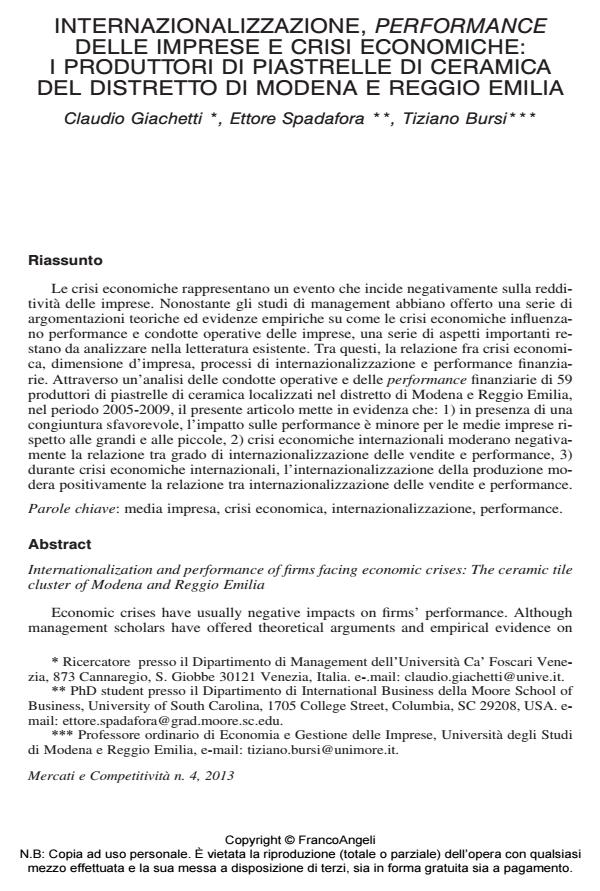Internationalization and performance of firms facing economic crises: The ceramic tile cluster of Modena and Reggio Emilia
Journal title MERCATI E COMPETITIVITÀ
Author/s Claudio Giachetti, Ettore Spadafora, Tiziano Bursi
Publishing Year 2013 Issue 2013/4
Language Italian Pages 22 P. 37-58 File size 540 KB
DOI 10.3280/MC2013-004003
DOI is like a bar code for intellectual property: to have more infomation
click here
Below, you can see the article first page
If you want to buy this article in PDF format, you can do it, following the instructions to buy download credits

FrancoAngeli is member of Publishers International Linking Association, Inc (PILA), a not-for-profit association which run the CrossRef service enabling links to and from online scholarly content.
Economic crises have usually negative impacts on firms’ performance. Although management scholars have offered theoretical arguments and empirical evidence on the effects of economic crises on firms’ performance, several gaps still remain. In particular, there is a lack of evidence on the relationship between economic crises, firm size, level of internationalization and financial performance. Using data on the strategic behavior and performance of 59 Italian ceramic tile manufacturers located within the industry cluster of Modena and Reggio Emilia, over the 2005-2009 time period, this study shows that: 1) during a global economic crisis, the performance of mediumsized firms is less penalized than that of large and small rivals, 2) a global economic crisis negatively moderates the relationship between internationalization and performance, 3) during a global economic crisis, the internationalization of manufacturing activities positively moderates the internationalization of sales-performance relationship.
Keywords: Medium-sized firm, economic crisis, internationalization, performance.
- Gli strumenti di misurazione delle strategie di content marketing: un confronto tra imprese italiane e inglesi Niccolò Gordini, Elisa Rancati, in MERCATI E COMPETITIVITÀ 1/2015 pp.45
DOI: 10.3280/MC2015-001004 - Effects of cultural distance on foreign acquisitions: evidence from italian acquired firms Michela Matarazzo, Gabriele Barbaresco, Resciniti Riccardo, in MERCATI & COMPETITIVITÀ 3/2016 pp.159
DOI: 10.3280/MC2016-003009
Claudio Giachetti, Ettore Spadafora, Tiziano Bursi, Internazionalizzazione, performance delle imprese e crisi economiche: i produttori di piastrelle di ceramica del distretto di Modena e Reggio Emilia in "MERCATI E COMPETITIVITÀ" 4/2013, pp 37-58, DOI: 10.3280/MC2013-004003